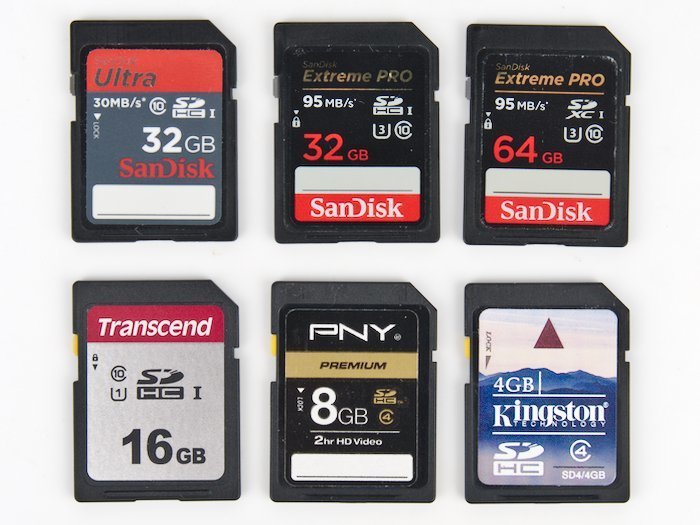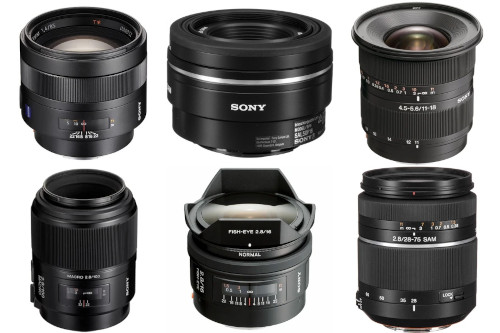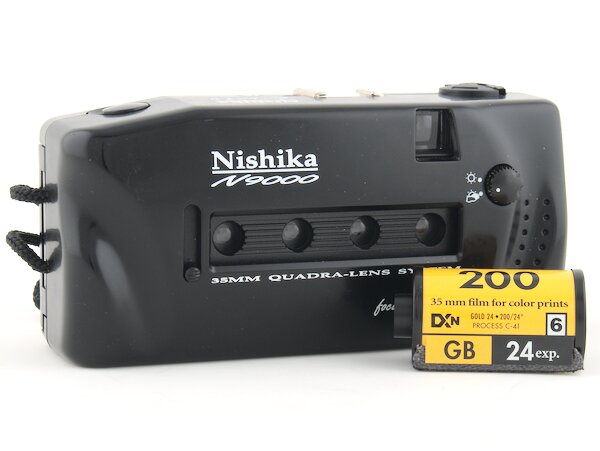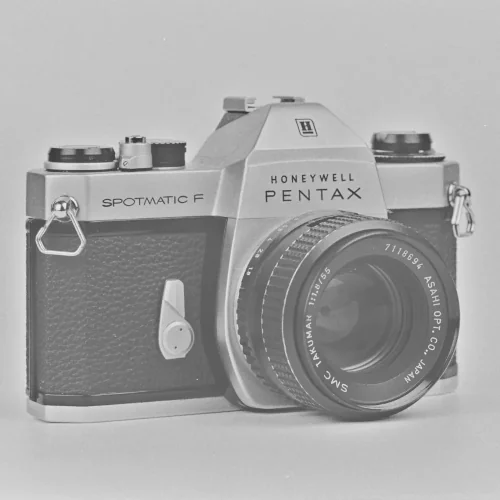
Vintage M42 Pentax Spotmatic Lenses for Photography
- Nathaniel Stephan
- Pentax spotmatic
- October 10, 2024
Table of Contents
There are tons of lenses available for the Pentax Spotmatic. The M42 lens mount is an open standard.
I am going to focus on what was made by Asahi Optical Co. Ltd (Pentax). I feel like it would ruin the experience of the camera to use newer lenses.
Spotmatic versions that have open aperture metering require the use of Super-Multi-Coated or SMC Takumar lenses for that feature to work:
- Pentax Electro Spotmatic
- Pentax Spotmatic ES
- Pentax Spotmatic ES II
- Pentax Spotmatic F
It doesn’t matter if the model is branded as Asahi Pentax Spotmatic or Honeywell Pentax Spotmatic.The difference is because Honeywell was the official US importer. Here is a page the covers the differences between Pentax Spotmatic versions.
Standard Lenses / Normal Prime Lenses / Kit Lenses
There were several kit Asahi Pentax Spotmatic lenses that changed over time. The kit lens varied by the Spotmatic version. The best lens options were for the Pentax Spotmatic F and other models with electronically controlled shutters. These normal lenses give the best vintage shooting experience.
Affiliate Advertising Disclosure
Outside the Shot is a participant in the Amazon Services LLC Associates Program, an affiliate advertising program designed to provide a means for sites to earn advertising fees by advertising and linking to Amazon.com.
As an eBay Partner, I may be compensated if you make a purchase. I also participate in affiliate advertising programs with KEH and Adorama. More can be found on the Affiliate Disclosure page.
Asahi Pentax Super-Multi-Costed Takumar 50mm f/1.4
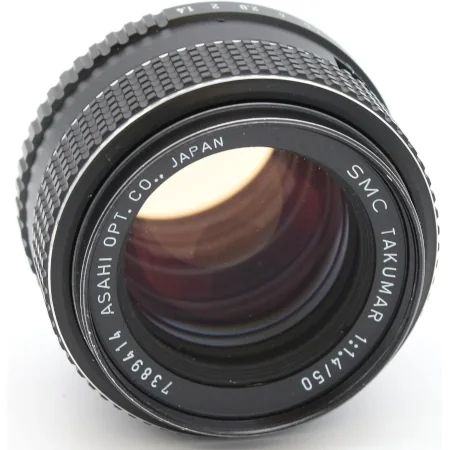
The Asahi Pentax Super-Multi-Coated Takumar 50mm f/1.4 lens is a fast normal lens that was produced in two “Super” versions as well as two versions with Super-Multi-Coating. It was introduced in 1964 and has a reputation for its sharpness, bokeh, handling, and value.
This is one of the best Pentax Spotmatic lenses to get in terms of value because there are lots of available copies.
The lens has 7 elements and features an infrared focusing mark to the left of the numeral ‘4’ on the DOF scale. The lens was produced from 1965 to 1971.
See current price and more information on:
Pros:
- High image quality: The lens is praised for its sharpness, contrast, and resolution. It is described as “sharp, crisp, lively” and is said to produce images that are a cross between Leitz and Pentax’s excellent A and FA lenses.
- Excellent handling: The lens is appreciated for its solid all-metal body and precise focus ring.
- Good value: Even with increasing prices, the lens remains affordable and very pleasing to use.
- Wide aperture: The extra stop at f/1.4 ensures a bright viewfinder that is indispensable for low-light or low ISO film.
Cons:
- Yellowing: The lens is subject to yellowing if stored but can be cleared by exposing to UV or sunlight.
SMC Takumar 55mm f/1.8
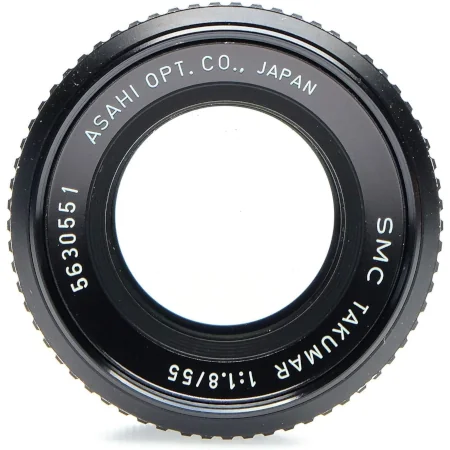
The Asahi SMC Takumar 55mm f/1.8 is a highly regarded lens for its sharpness, vibrant colors, and bokeh. It is a fast 55mm screwmount lens that existed in several versions, all with the same optical design.
Versions are less expensive than the 50mm f/1.4 above. It would be an excellent choice for a single lens to use with a Spotmatic.
The 1965 version, has a lens element that has thorium oxide in it which yellows over time. The yellowing can be removed with exposure to sunlight.
See current price and more information on:
Pros:
- Sharpness: The lens is sharp even when fully open, and the sharpness improves further a stop or two down.
- Vibrant Colors: The lens exhibits very rich and vibrant colors, which is a characteristic appreciated by many photographers.
- Bokeh: The bokeh produced by this lens is considered among the best.
- Build Quality: The build quality of the lens is extremely high, and it is often compared favorably to modern lenses.
- Value for Money: Given its performance, the lens is considered a great value for the money.
Cons:
- Yellowing Over Time: The radioactive glass elements in the lens can yellow over time, potentially affecting image quality.
Wide Angle Lenses
Super-Multi-Coated Takumar 28mm f/3.5
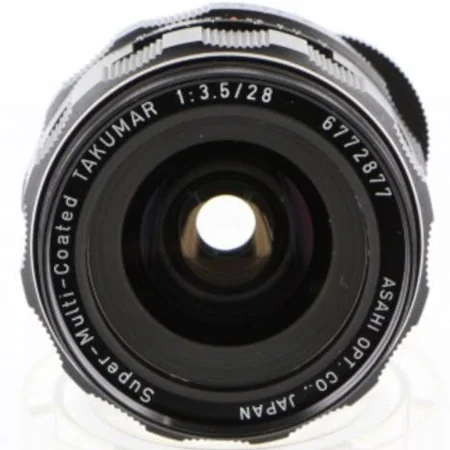
The Super Takumar 28mm f/3.5 lens was produced in several versions over time. The lens is known for its sharpness, handling, and value. All the versions of the lens are inexpensive on the used market.
The lens came in two models with different optics. The first model has a 58mm filter size, while the second model has a 49mm filter size. The first model features a slightly differently designed distance scale than the second model. The final release of this lens was a Super-Multi-Coated model with improved coating but otherwise with the same optics as the second Super-Takumar model.
See current price and more information on:
Pros:
- Compact and lightweight, making it easy to handle and carry.
- Good sharpness and aberration control, producing high-quality images.
- The lens has a good value for its price.
- The build quality is superb, which is a characteristic of Takumar lenses.
Cons:
- The lens is relatively slow with a maximum aperture of F3.5, which can make it challenging to use in low light conditions.
- The lens has some distortion and might show dark corners at wide apertures.
Super Multi Coated Takumar 35mm f/3.5
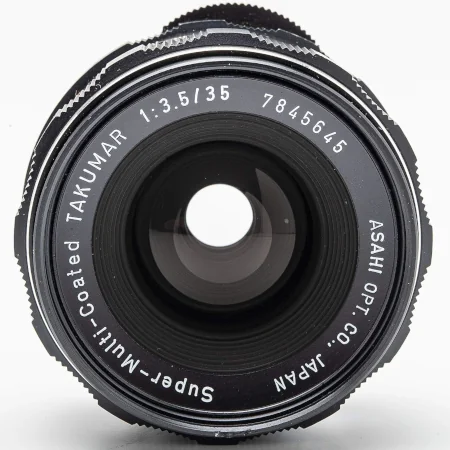
The Super Takumar 35mm f/3.5 lens is a compact, lightweight lens with a solid build quality. The lens is an excellent choice for street photography. It was introduced in 1959 and its optical design remained unchanged all the way to a K-mount version.
The lens came in a total of five M42 versions plus the K-mount version. The Super Takumar versions can easily be distinguished from each other based on the smallest F-stop and the presence of a “window” on the distance scale.
The lens is praised for its sharpness, color saturation, handling, and value. It is ideal for capturing vibrant and detailed images. It is also appreciated for its flare resistance.
See current price and more information on:
Pros:
- Compact and lightweight, making it easy to carry around.
- Excellent build quality, typical of Takumar lenses.
- High sharpness and good handling.
- Great color saturation and micro-contrast.
- Good flare resistance.
Cons:
- Slow max aperture, which can be a limitation in low light conditions.
- Bokeh is not as smooth or pleasing as some other lenses.
Super Multi Coated Takumar 24mm f/3.5
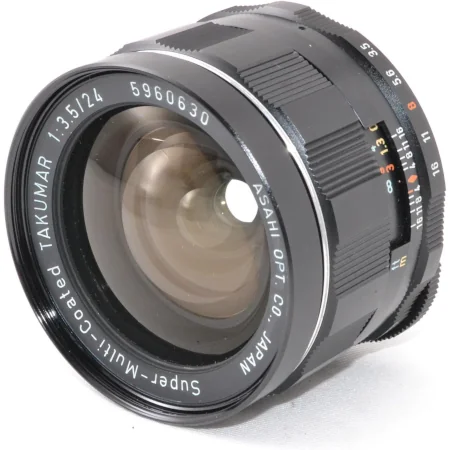
The Super Multi Coated Takumar 24mm f/3.5 is a wide-angle lens that was produced in both Super-Multi-Coated and Super versions, which are optically identical. It was manufactured from 1972 to 1976.
The lens is designed for full-frame / 35mm film and has an M42 mount. It has an aperture range from f/3.5 to f/16 and a manual focus system with a minimum focus distance of 25 cm. It has 9 elements in 8 groups and a 5-blade diaphragm.
See current price and more information on:
Pros:
- Excellent center sharpness, even wide open.
- Good handling and build quality, typical of Takumar lenses.
- The close minimum focus distance of 25 cm allows for interesting perspectives and compositions.
- The lens is compact and has a good weight, making it comfortable to use.
- The lens hood is well-designed and effective.
Cons:
- The edges of the image can be soft when the lens is used wide open.
- Some users have reported chromatic aberration, particularly towards the edges of the image.
- The lens is not as fast as some modern lenses, which might limit its use in low light conditions.
- The lens may show flare when shooting in direct light, so using a lens hood is recommended.
SMC Takumar 20mm f/4.5
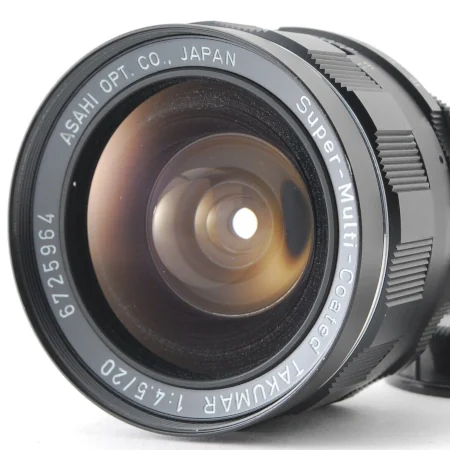
The Super Takumar 20mm F4.5 is a super wide-angle lens that was produced between 1968 and 1975. It exists in both Super-Multi-Coated and Super variants. The lens is designed for full-frame / 35mm film and uses an M42 mount. It has an aperture range from F4.5 to F16, and it features manual focusing with a minimum focus distance of 20 cm.
It has a filter size of 58mm, but Pentax recommended using 77mm filters with a step-up ring to avoid vignetting. The lens weighs between 246g and 251g depending on the variant.
See current price and more information on:
Pros:
- Wide field of view.
- The lens is sharp in the center, especially when stopped down to at least f/8 or f/11.
- It has a close minimum focus distance, opening up possibilities for near macro work.
- The lens has a unique rendering style, producing images with deep natural colors, fine detail, and a sense of depth and dimensionality.
Cons:
- The lens has noticeable distortion and chromatic aberration, especially outside the center.
- The lens is relatively slow with a maximum aperture of F4.5, making it more difficult to focus with a split image prism.
- The lens is softer at the edges, even when stopped down and is prone to vignetting.
- The lens flares, but this can be mitigated with the use of a lens shade.
Telephoto Lenses
There are several telephoto lenses for the Pentax Spotmatic that are great values. The longer telephot prime lenses are better choices in my opinion. More of them were originally sold, so the prices are affordable. The Pentax 85mm lenses are some of the most expensive M42 lenses for the Spotmatic.
Super-Multi-Coated Takumar 135mm f/2.5
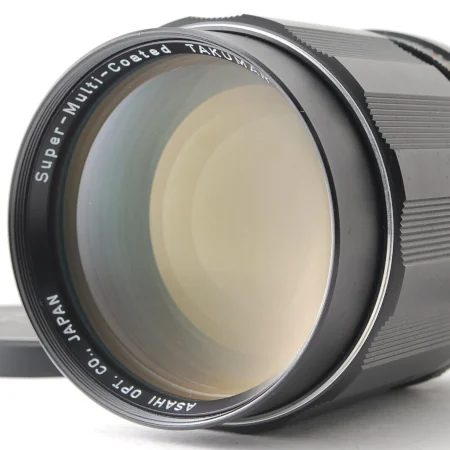
This is a telephoto lens that is often praised for its sharpness and compact size. The longer telephoto options available, like the 200mm, are more expensive. This is a great choice for portraits as it is one of the faster telephoto M42 lenses available for the Spotmatic.
The Super-Multi-Coated Takumar 135mm F2.5 is a fast telephoto lens that came in two optical designs, the earlier with five elements, the later with 6 elements. The two Super-Multi-Coated variants support open-aperture metering with the Spotmatic F, ES, and ESII.
See current price and more information on:
Pros:
- The lens is known for its sharpness and bokeh, making it ideal for portrait photography.
- The Super-Multi-Coated variants support open-aperture metering with the Spotmatic F, ES, and ESII, which can be a significant advantage for users of these cameras.
- The lens has a solid build and great handling, which can enhance the user experience.
Cons:
- The lens is quite heavy, which might be a disadvantage for some users.
- The lens is subject to more chromatic aberration than newer lenses.
- Manual focusing with this lens can be challenging and requires practice.
Super-Multi-Coated Takumar 105mm f/2.8
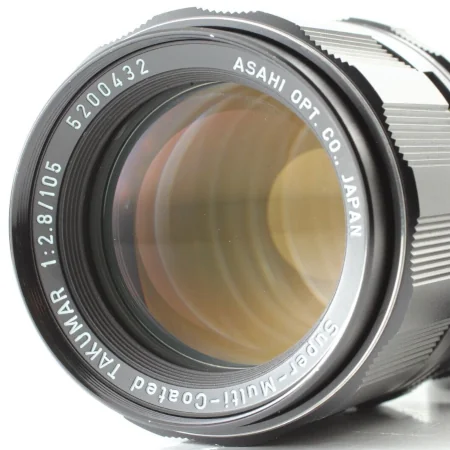
The Super-Multi-Coated Takumar 105mm f/2.8 is a telephoto lens with a solid build and excellent sharpness. It has an optical formula that exists in one Takumar version, two Super-Takumar versions, and one Super-Multi-Coated Takumar version. The Super-Multi-Coated version supports open aperture metering with the Spotmatic F, ES, and ESII.
The lens has a 5-element design, similar to the 135mm f/3.5, and was improved with the advent of S-M-C coatings in 1971. It has six aperture blades and a 49mm filter ring. The lens is sharp even at f/2.8, although the depth of field is limited at this aperture. The sharpness improves significantly when stopped down to f/5.6 or f/8.
See current price and more information on:
Pros:
- Excellent sharpness, especially when stopped down.
- Great color rendition with chromatic aberration.
- Compact and lightweight, making it easy to handle.
- Good performance in low light at f/2.8.
Cons:
- Soft when used wide open, which may not be ideal for all types of photography.
- Some chromatic aberration in high contrast areas.
- Can have harsh bokeh with out of focus pinpoint highlights.
Super-Multi-Coated Takumar 85mm f/1.8
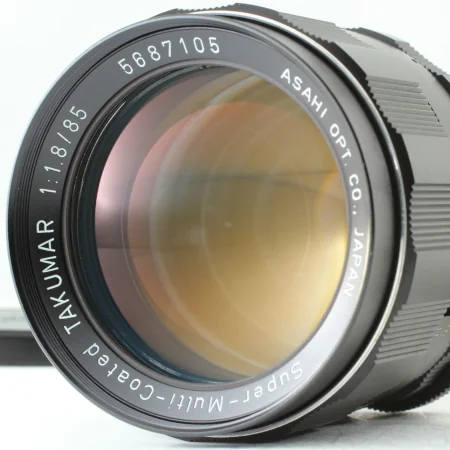
The Super-Multi-Coated Takumar 85mm f/1.8 is a highly regarded lens among Pentax users. It was introduced in 1972 and is known for its excellent image quality and solid build. It is a popular lens to adapt to mirrorless digital cameras for portaits, which keeps prices relatively high.
It’s the fastest of the 85mm screwmount lenses and is of a different optical construction than the original version introduced in 1960.
There is also another Pentax 85mm lens, the Super-Multi-Coated Takumar/Super-Takumar 85mm Ff/.9
Pros:
- Excellent image quality with pleasing bokeh.
- The lens is built like a tank, with a smooth focus ring and a quality feel.
Cons:
- The lens can be expensive and hard to find in good condition due to its age and rarity. It’s becoming a collector’s item and prices are expected to continue to rise.
Zoom Lenses
These are only here because I know people want to see them. Vintage zoom lenses are the lenses that are most prone to problems. The helicoid grease in the zoom mechanism dries out or breaks down. The result is either a locked up zoom ring or sloppy movement.
Additionally, they have more problems with fungus, haze, dust, and balsam separation. The various problems are so prevalent that it is difficult to find a zoom lens in what I would consider is good usable condition.
Super-Multi-Coated Takumar 85-210mm f/4.5
The Super-Multi-Coated Takumar 85-210mm f/4.5 is a telephoto zoom lens that offers a unique focal length range, making it suitable for a variety of shooting scenarios. It is a one-touch telephoto zoom with a very useful range.
The lens has an 11-element design and a 6-blade diaphragm. It has a minimum focus distance of 350 cm and a maximum magnification of 0.067x. It has a dedicated two-part screw-in hood and a metal push-on lens cap.
See current price and more information on:
Pros:
- The focal length range of 85-210mm.
Cons:
- The lens is quite heavy.
- The lens can show some purple fringing in high contrast areas.
- Manual focusing with this lens can be challenging and requires practice.
- The lens is not fast, which might limit its use in low light conditions.
Macro Lenses
Macro photography can be lots of fun. These lenses offer a much better experience than using a extension tube on a standard prime lens. The flat field of view and longer focus throw are big advantages.
Super-Multi-Coated Macro-Takumar 50mm f/4
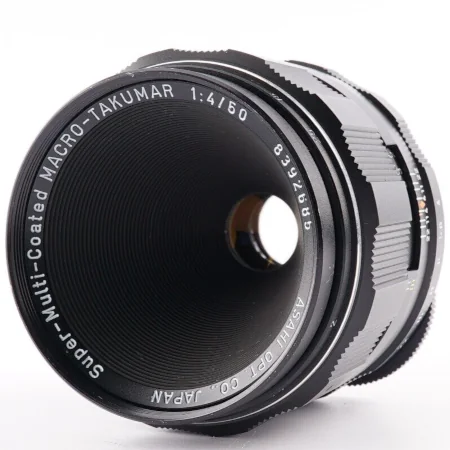
Super-Multi-Coated Macro-Takumar 50mm f/4: This is a macro lens that allows for close-up photography with a 1:1 magnification ratio.
The Super-Multi-Coated Macro-Takumar 50mm f/4 is a highly regarded lens among the Pentax community. It’s known for its sharpness, color rendering, and build quality. The lens has an average user rating of 9.61 out of 10, and it’s recommended by 100% of reviewers on the Pentax Forums.
The lens has a maximum aperture of f/4 and a minimum aperture of f/22. It has manual focusing with a minimum focus distance of 23 cm and a maximum magnification of 0.5x. The lens has a filter size of 49mm.
See current price and more information on:
Pros:
- Excellent sharpness and color rendering.
- Smooth and precise manual focusing.
- Solid build quality typical of Takumar lenses.
- Good value for the price, especially considering its performance.
- Capable of 1:1 macro in the preset version.
Cons:
- The lens is only f/4, which can make the viewfinder dimmer for focusing.
- The lens only goes to 0.5x magnification in the Super-Macro-Takumar version. It requires a 25mm extension tube for 1x magnification.
Super-Multi-Coated Macro-Takumar 100mm f/4
The Super-Multi-Coated Macro-Takumar 100mm F4 Macro is a screwmount macro lens designed for full-frame/35mm film. It has an aperture range from F4 to F22 and a minimum focus distance of 45 cm.
The lens is equipped with automatic diaphragm and 6 blades. It has a max magnification of 0.5x and a filter size of 49mm. It weighs 350g and was first produced in 1972.
See current price and more information on:
Pros:
- The lens is sharp corner to corner with a flat field of view.
- The lens is well-constructed and durable.
- The lens provides accurate focus, which is beneficial for macro photography.
- For its price, the lens offers excellent performance and quality.
Cons:
- The lens only provides 1:2 macro. For 1:1 macro a 50mm extension tube needs to be used.
- The maximum aperture is f/4, which might be limiting in low light conditions.
Fish Eye Lenses
Fish eye lenses create an interesting effect. Due to their either fixed focus or large hyperfocal range, they are some of the most popular lenses to adapt to mirrorless cameras. Due to this and their limited original sales, prices of fisheye lenses can be very high.
Super Multi Coated Fish-Eye-Takumar 17mm f/4
The Super Multi Coated Fish-Eye-Takumar 17mm f/4 is a fast fish-eye lens that completely covers the 24x36mm full frame format. It features a 180-degree angle of view diagonally. The lens came in two variants, the Fish-Eye-Takumar 1:4/17 and the Super-Multi-Coated FISH-EYE-TAKUMAR 1:4/17. The Super-Multi-Coated version supports open aperture metering with the Spotmatic F, ES, and ES II.
The lens has an automatic diaphragm with 6 blades and manual focusing. It has a minimum focus distance of 20 cm. The lens also features built-in filters, a rear filter mount, and a fisheye. The lens was produced from 1967 to 1976.
See current price and more information on:
Pros:
- Wide field of view.
- Good sharpness when stopped down.
- Built-in filters for black and white photography.
- Compact and easy to handle.
Cons:
- The front focus ring can be flimsy and may slip through the focus rotation.
- Diffraction can occur at f/11.
- The front element is easily scratched.
- The built-in filters do not lock in place very well and can be accidentally rotated.
Fish-Eye-Takumar 18mm f/11
The Fish-Eye-Takumar 18mm f/11 is a unique lens that provides a field of view of 180 degrees and covers the 24x36mm full frame image area. It has a fixed focus, meaning there is no focusing ring. The aperture ring only has four positions (11, 16, 22, and 32), and the diaphragm is a perforated disc with a perfectly circular opening for each of the four F-stop settings. The lens was produced from 1963 to 1967.
See current price and more information on:
Pros:
- It offers a unique and artistic perspective with its fish-eye effect.
- The lens is extremely compact, almost appearing as a body cap, making it easy to carry.
- The center sharpness is quite good with a fairly high degree of contrast.
- It’s easy to use due to its fixed focus and limited aperture settings.
Cons:
- The lens is slow with a maximum aperture of f/11.
- The edges and corners of the images can be soft, and there is some vignetting due to the image circle not quite covering the corners.
The M42 Lens Mount: A Historical and Technical Overview
The M42 mount was first introduced in 1949 by the German camera manufacturer Zeiss Ikon, as part of their Contax S camera. This was the first camera to combine the features of a 35mm SLR (Single Lens Reflex) camera with a thread mount.
The M42 mount was a departure from the bayonet mounts that were commonly used in SLRs at the time. The M42 mount offered a simple and robust connection between the camera body and lens.
The M42 mount quickly gained popularity due to its simplicity and universal design. It allowed for a wide range of M42 lenses to be used interchangeably on different camera bodies, fostering greater creative flexibility for photographers.
Asahi Pentax used the M42 mount extensively in their early SLR cameras, leading to the mount often being referred to as the “Pentax screw mount”.
Helpful Pentax Spotmatic Technical Specifications
| Specification | Value |
|---|---|
| Type | Screw mount |
| Diameter | 42mm |
| Thread Pitch | 1mm |
| Flange Focal Distance | 45.46mm |
The flange focal distance, or the distance from the mounting flange to the film plane, is 45.46mm. This relatively long distance compared to other mounts, which later allowed for the inclusion of additional mechanisms within the camera body, such as automatic aperture control.
One of the key features of the M42 lens mount is its universality. Unlike bayonet mounts, which often require complex alignment and can vary significantly between manufacturers, the M42’s simple screw design is largely standardized. This has allowed a wide range of lenses and cameras from different manufacturers to be compatible with the mount.
All models have a focal plane shutter with a shutter speed for flash sync of 1/60 of a second. This is indicated by a lightning bolt icon on the shutter speed dial. To get around issues with slow lenses, a Spotmatic II or later version with a hot shoe can be helpful as they make using an electronic flash easier.
The name of the Spotmatic implies that it has spot metering, but they do not. They all have center weighted average TTL metering, with the exception of the Spotmatic SL.
Battery Requirements
Earlier Spotmatics used a mercury battery. The Spotmatic SL doesn’t have any electronics.
These models are fully mechanical. Their shutters will fire without a battery:
- Pentax Spotmatic SL
- Pentax Spotmatic SP
- Pentax Spotmatic SP 500
- Pentax Spotmatic SP 1000
- Pentax Spotmatic II
- Pentax Spotmatic IIa
Later models have an electronic shutter that requires a battery to operate. These were designed for use with silver oxide batteries, which are still available today. Alkaline batteries can also be used, but they tend to not hold a charge for as long.
Corrosion in the battery compartment is a common problem for Spotmatic cameras. This is because batteries would get left in the cameras for long periods of time. Battery corrosion can be cleaned with a small amount of distilled white vinegar on a cotton swab.
Auto/Man Switch
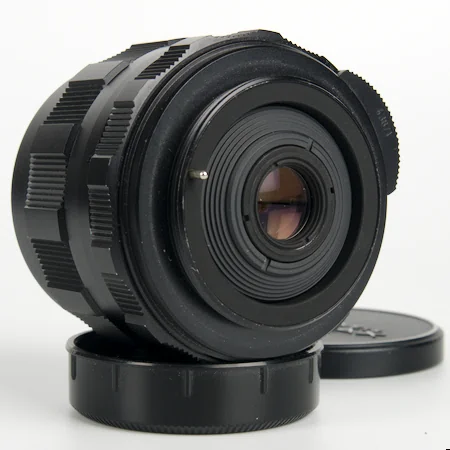
Auto first meant automatically stopping down a lens aperture when the shutter button was pressed. This allowed focusing with the lens wide open, allowing the most light possible into the viewfinder of an SLR.
When the shutter button was pressed, the lens aperture would automatically be closed, giving the desired depth of field.
The Auto/Man switch controls the aperture. When it is set to Auto, the aperture will be stopped down when the silver stopdown pin is depressed.
When the switch is set to Man, the lens will be stopped down (the aperture will close) when the aperture ring is turned. This allows Pentax Spotmatic lenses to be backwards compatible with older camera models and ones made by other manufacturers.
